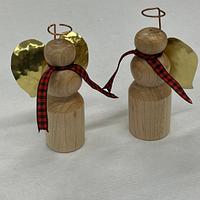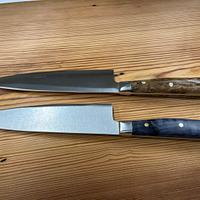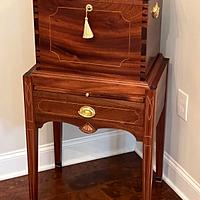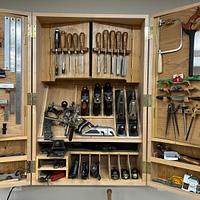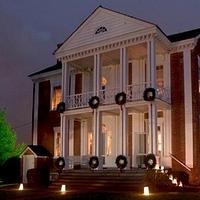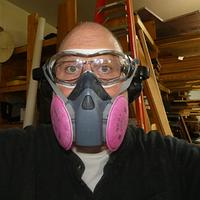Share your craft projects
Make new craft buddies
Ask craft questions
Blog your craft journey

Carey Mitchell
169 posts
and
11 followers
in almost 3 years
in almost 3 years
More from Carey Mitchell
Simple Cutting board - with a history
This piece has been lying around for about 50 years so I finally did something productive with it. It doesn't look great compared to many, well, most, most cutting boards, but.......
Its history is the reason I have kept it all these years. In 1841 my great, great grandfather bought 160 acres of what had been the Vann plantation in Spring Place, GA; I have the deed. Vann was a Cherokee chief who became incredibly rich by learning and adopting the white man's business expertise. The Vann House was completed in 1804, and is a state historic site today; I am on the Board of Trustees. The Cherokees were "removed" to Oklahoma via the Trail of Tears in 1838. A different great, great grandfather owned the Vann House from 1875-1879.
The Cole family home was built across from the Vann plantation house about 1842 of local materials. This piece was part of a board used as a shelf in the house. The house was ransacked during the 1861-1865 "unpleasantness" between north and south. My grandfather salvaged some boards during a renovation in the 1950s, and used this for shelving in a storage building; this was an offcut. I got it in the early 1970s. It was 15" x 1 1/8," but I planed out some twist.
Soooo, its ready for another life.
The 2nd photo is the Vann House; ca. 1804, as it stands today. It was built by the Cherokee chief, James Vann, who invested in every moneymaking venture in the area, from Chattanooga almost to Atlanta. He owned 3 plantations, sawmills, distilleries, toll roads, ferries, taverns, etc.; if it made money, he was in it. Following his murder, his son Joseph took charge and increased the fortune, to the point that President Monroe visited in 1819 to meet that fabulously wealthy native American.
The interior trimwork was all hand carved by slaves (yes, the Cherokees owned slaves), including magnificent 12 foot tall mantles. The exterior walls are solid brick, 2 feet thick; interior walls are also solid, 1 foot thick. There is an unsupported cantilevered staircase that was the earliest known in the south (since braced by the state for safety). Its filled with period antiques, which I maintain and repair. there is a grandfather clock, made in London in 1795, that still works and chimes, as well as a Queen Anne highboy made in Savannah, ca. 1790. We needed a small piece for the dining room, so that was the reason I built the QA lowboy, shown in place in another post. The empire stool shown on that "other site" is also in the house.
I was elected as a trustee several years ago. We decorate the house for tours by candlelight every Christmas, in the original style adopted from the Moravian missionaries that Vann brought in to educate the Cherokee children. While conducting tours this year, I learned from a distant relative that yet another relative, my maternal grandfather's uncle, also owned the house around 1850 - so I am completely immersed in the history !
https://vanishinggeorgia.com/2022/06/12/chief-james-vann-house-1804-spring-place/
The 2nd photo is the Vann House; ca. 1804, as it stands today. It was built by the Cherokee chief, James Vann, who invested in every moneymaking venture in the area, from Chattanooga almost to Atlanta. He owned 3 plantations, sawmills, distilleries, toll roads, ferries, taverns, etc.; if it made money, he was in it. Following his murder, his son Joseph took charge and increased the fortune, to the point that President Monroe visited in 1819 to meet that fabulously wealthy native American.
The interior trimwork was all hand carved by slaves (yes, the Cherokees owned slaves), including magnificent 12 foot tall mantles. The exterior walls are solid brick, 2 feet thick; interior walls are also solid, 1 foot thick. There is an unsupported cantilevered staircase that was the earliest known in the south (since braced by the state for safety). Its filled with period antiques, which I maintain and repair. there is a grandfather clock, made in London in 1795, that still works and chimes, as well as a Queen Anne highboy made in Savannah, ca. 1790. We needed a small piece for the dining room, so that was the reason I built the QA lowboy, shown in place in another post. The empire stool shown on that "other site" is also in the house.
I was elected as a trustee several years ago. We decorate the house for tours by candlelight every Christmas, in the original style adopted from the Moravian missionaries that Vann brought in to educate the Cherokee children. While conducting tours this year, I learned from a distant relative that yet another relative, my maternal grandfather's uncle, also owned the house around 1850 - so I am completely immersed in the history !
https://vanishinggeorgia.com/2022/06/12/chief-james-vann-house-1804-spring-place/
Carey Mitchell
8 Comments
Awesome history!
great story !
working with my hands is a joy,it gives me a sense of fulfillment,somthing so many seek and so few find.-SAM MALOOF.
Wonderful piece of history, used and not idle. well done.
Ron
Awesome story!
Gotta love an old growth cutting board. Awesome story too.
Nice story!
Petey
Nice keeping your family history going for so long.
Love it Carey! the board is functional and beautiful at the same time....thanks for the background too.....I love history!
Mike









